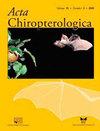Effects of Pine Forest Management Practices on Bat Functional Traits in a Subtropical Region
IF 0.7
4区 生物学
Q4 ZOOLOGY
引用次数: 0
Abstract
Changes in landscape environmental characteristics may influence habitat use by bat species as well as species composition and community functional structure. Landscape features may drive the functional role variability of bat species on the ecosystems. Consequently, landscapes may change the degree of functional differentiation between species. We have evaluated the effect of pine forest monoculture and their environmental characteristics on the distribution and functional attributes of bat species. We sampled bat communities in areas with high (three sites) and low (three sites) forest land use management practices including six mist-netting locations in order to sample for bats at each site. In addition, we have also measured temperature, humidity, percentage of land use coverage (managed forest, agriculture, and native forest), and percentage of canopy openness at each site. We captured 87 bats belonging to eight species representing two families: Phyllostomidae and Vespertilionidae. For the functional analysis, we used three functional attributes to describe wing morphology: wing loading, aspect ratio, and forearm length. No significant effect of any environmental variable was observed on bat species composition. However, bat species distribution was driven by the ability associated with their functional attributes to occupy the space. Moreover, forearm length was positively correlated with forest cover, canopy openness, and humidity. Species with similar wing morphology have responded in a similar way to environmental variables in the studied areas. Functional dispersion was high in the native forest. The monoculture of exotic species may increase the functional attributes related with vulnerability as described by bat wing morphology. Therefore, the native forest conversion to pine forest monoculture may increase the loss of functional attributes in the bat community.亚热带松林管理措施对蝙蝠功能性状的影响
景观环境特征的变化可能会影响蝙蝠物种的栖息地利用以及物种组成和群落功能结构。景观特征可能会驱动蝙蝠物种在生态系统中的功能角色变化。因此,景观可能会改变物种之间的功能分化程度。我们评估了松林单一栽培及其环境特征对蝙蝠物种分布和功能属性的影响。我们对高(三个地点)和低(三个地方)林地利用管理实践地区的蝙蝠群落进行了采样,包括六个雾网位置,以便在每个地点对蝙蝠进行采样。此外,我们还测量了每个地点的温度、湿度、土地利用覆盖率(管理森林、农业和原生森林)和树冠开放率。我们捕获了87只蝙蝠,它们分属八个物种,分别代表两个科:Phyllostomicae和Vespertionidae。在功能分析中,我们使用了三个功能属性来描述机翼形态:机翼载荷、纵横比和前臂长度。没有观察到任何环境变量对蝙蝠物种组成的显著影响。然而,蝙蝠物种的分布是由与其功能属性相关的占据空间的能力驱动的。此外,前臂长度与森林覆盖率、冠层开放度和湿度呈正相关。在研究区域,翅膀形态相似的物种对环境变量的反应相似。原生森林的功能分散性很高。外来物种的单一栽培可能会增加蝙蝠翅膀形态所描述的与脆弱性相关的功能属性。因此,原生林向松林单一栽培的转变可能会增加蝙蝠群落功能属性的丧失。
本文章由计算机程序翻译,如有差异,请以英文原文为准。
求助全文
约1分钟内获得全文
求助全文
来源期刊

Acta Chiropterologica
生物-动物学
CiteScore
2.50
自引率
20.00%
发文量
42
审稿时长
>12 weeks
期刊介绍:
Acta Chiropterologica, published by the Museum and Institute of Zoology at the Polish Academy of Sciences, is devoted solely to the study and discussion of bats.
 求助内容:
求助内容: 应助结果提醒方式:
应助结果提醒方式:


